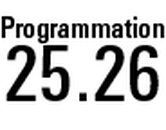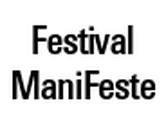Déroulé pédagogique du Cursus
Avec l’arrivée d’Eva Reiter, nouvelle compositrice associée, des adaptations du programme pédagogique du Cursus sont actuellement à l’étude. Des précisions seront apportées en 2025-2026.
Les enseignements sont donnés en anglais.
Les cours ont lieu à l’Ircam du lundi au vendredi de 10h à 13h et de 14h30 à 17h30.* Il y a deux semaines de congés au mois de décembre pour les vacances de Noël.
* informations pouvant être soumises à modifications
Durée de la formation : 850h incluant des cours théoriques, des ateliers pratiques, des sessions de composition, des conférences assurées par des artistes invités et des scientifiques, un suivi individuel, des répétitions et un concert.
![]()
Objectifs
- Avoir une vision globale du poste de travail du compositeur utilisant l’informatique et les nouvelles technologies appliquées à la composition ;
- Prendre conscience des problématiques théoriques et compositionnelles qu’engendrent l’utilisation de l’informatique musicale, particulièrement dans les domaines de la CAO, du traitement du signal, de la synthèse sonore et de l’écriture de l’interaction, et trouver les moyens de les appliquer dans la réalisation du projet de composition mixte.
- Acquérir les compétences pratiques pour l’utilisation des principaux environnements développés à l’Ircam dans ces domaines, comprendre leur interaction et être capable de les intégrer dans un processus de composition ;
- Expérimenter le processus de réalisation d’une étude avec électronique en temps réel pouvant inclure d’autres médiums (texte, images, danse…) dans toutes ses étapes : conception esthétique, écriture instrumentale et électronique, réalisation informatique (écriture d’un « patch de concert »), travail de répétition et de production.
![]()
Ressources pédagogiques
Environnement de travail
Ordinateurs Mac, équipement audio et MIDI.
Locaux
Une salle de cours équipée de 10 ordinateurs avec installation audio et équipement MIDI.
Trois studios de travail avec équipement audio et MIDI, ordinateur Apple Macintosh, 4 ou 8 points d’écoute,
Deux postes de travail avec équipement audio et MIDI, ordinateur Apple Macintosh et 2 points d’écoute.
Documentation
La médiathèque de l’Ircam est accessible du mardi au vendredi de 14h à 17h30.
Intensive et à temps plein, le programme « Cursus » propose un panorama complet du poste de travail du compositeur et de la compositrice utilisant l’informatique et les nouvelles technologies appliquées à la composition, notamment dans les domaines de la CAO, du traitement du signal, de la synthèse sonore et de l’écriture de l’interaction.
Les différents mini-projets qui structurent la première partie de l’année (d’octobre à avril) sont des étapes-clé permettant aux stagiaires d’acquérir les compétences pratiques nécessaires pour l’utilisation des principaux environnements développés à l’Ircam et d’être capable de les intégrer dans un processus de composition.
L’année est également rythmée par des interventions d’artistes invités, des sessions de composition, des workshops sur des thématiques identifiées (image, danse, texte, improvisation) avec le compositeur associé au Cursus Pierre Jodlowski. Ces rendez-vous artistiques et collectifs visent à apporter un éclairage sur la thématique abordée lors de ces sessions et à questionner les stagiaires sur leur propre processus de création et ses enjeux.
À cette première phase d’apprentissage, succède une seconde période (de mai à septembre) qui se concentre sur l’écriture et la réalisation du projet final du compositeur ou de la compositrice, présenté à l’Ircam à l’issue du programme en septembre.
![]()
Programme pédagogique du Cursus
D’octobre à février – Phase programme
Mini-projet 1 : workshop image
Objectifs
- Maîtriser les bases de l’audio numérique
- Enregistrer, numériser et préparer des échantillons sonores
- Savoir utiliser TS2 pour les traitements du son
- Savoir utiliser Reaper
- Maitriser les bases des logiciels Max et Open Music
Enseignements
Acoustique, audio numérique
- Techniques de studio (enregistrement, mixage, préparation d’échantillonnages…)
- Étude du logiciel Reaper (montage, mixage, mastering, sauvegarde)
Analyse, synthèse et traitement du son
- Traitement FFT
- Logiciel TS2 : analyse, montage, traitement, automatisation, master
Introduction au logiciel Max
Introduction au logiciel Open Music à travers l’utilisation des fonctions audio
- Fabrication d’une synthèse granulaire
- Calcul du niveau RMS
Workshop Image conduit par Pierre Jodlowski
Réflexion sur le rapport musique/image, présentation des différentes stratégies d’écriture avec ces mediums, réflexion sur les supports de projection dans le cadre de projets de type installation ou performance. Invitation d’artistes plasticiens.
Mini projet n°1 : étude électroacoustique
Réaliser une courte pièce électroacoustique sur un court extrait de film afin de valider les apprentissages de ce premier module. Ce premier mini-project est en outre le moyen de commencer à identifier des stratégies d’intégration de médias en vue de la réalisation finale.
Mini-projet 2 : workshop texte / poésie
Objectifs
- Maitriser les fonctionnalités principales de Live
- Connaitre les différences entre Max et Max For Live, fabriquer des effets, savoir synchroniser un processus au tempo de Live
- Approfondir la question de la formalisation musicale
Enseignements
Introduction à Live
- Clips MIDI, clips Audio, Scenes, effets audio, Synthèse oustractive
- FM – instruments (Analog, Operator)
Introduction Max For Live
- Élaboration de quelques outils de traitement et de synthèse
- Intégration d’un module de suivi de la voix (Voice Follower)
Composition Assistée par Ordinateur (CAO)
- Open Music
- Chord-seq
- Manipulation des listes - <x-dx> <dsx->x>
- Introduction à la maquette
Workshop texte conduit par Pierre Jodlowski
Présentation des enjeux liés à l’intégration d’éléments textuels dans un projet compositionnel.
Atelier technique autour de la voix (hardware, software, mise en situation).
Travail avec un.e poète ainsi qu’avec un .e comédien.ne pour une phase d’expérimentation collective.
Mini projet n°2 : projet sur un court extrait d’un texte ou d’une poésie
Préparer une session Live permettant d’interagir avec la voix parlée ou chantée ; identifier les problématiques d’amplification de la voix en fonction du type de source, s’approprier la prise de parole (mise en situation théâtrale) ; identifier le « poids » des phénomènes sonores et musicaux dans un contexte de composition avec du texte.
Mini-projet 3 : workshop danse
Objectifs
- Savoir utiliser des capteurs dans Max For Live
- Introduction aux capteurs R-iOT : savoir comment marche un accéléromètre, savoir interpréter les données, les traiter, les assigner au contrôle de processus
Enseignements
- Max et capteurs : réception, traitement des données de capteurs
- Mise en place d’un système de mapping
- Mise en application avec les R-iOTs
- Sonification : piloter de la synthèse ou des sons avec les capteurs pour lier le son au geste
Workshop danse conduit par Pierre Jodlowski
Identification du rôle du corps dans la pratique de la composition (le corps des musicien.ne.s, le corps – performatif). Travail avec un.e chorégraphe et un.e ou plusieurs danseur.euse.s sous la forme d’un atelier participatif (expérience de son propre rapport au corps).
Mini projet n°3 : Danse / musique / temps réel / contrôleurs
Ce projet a pour but d’identifier et tester des dispositifs d’interaction avec le corps ; en particulier lors des journées de travail avec les danseur.euse.s mais plus généralement afin d’identifier les paradigmes liés à l’écriture du geste (utilisation de capteurs, partitions chorégraphiques, outils disponibles dans l’environnement Max For Live et Max…)
Mini-projet 4 : workshop improvisation
Objectifs
- Apprendre à structurer un patch Max pour la performance
- Utiliser des paramètres du son et des descripteurs pour piloter des traitements
- S’initier aux logiciels d’improvisation développés à l’Ircam
- S’initier à la synthèse par modèle physique avec Modalys
- Concevoir un patch Max et / ou des outils-instruments dédiés à l’improvisation
Enseignements
Max
Traitements, suivi de paramètres (amplitude, fØ, etc.), descripteurs
CAO
Improviser avec deux logiciels développés dans l’équipe Représentations musicales : Omax et DY2CI
Synthèse par Modèles physiques - Modalys
- Introduction au langage de programmation Lisp
- Construction d'instruments dans les interfaces Lisp et Max
Workshop improvisation conduit par Pierre Jodlowski, avec un.e compositeur.rice invité.e.
Session collective, impliquant la participation de l’ensemble du groupe : solo, duo ou par petits groupes, tous ensemble. Réflexion sur les outils, sur la musicalité, sur la forme, sur la conduite d’une improvisation. Invitation d’un.e compositeur.rice et improvisateur.rice qui abordera également l’influence de l’improvisation dans son travail de composition.
Mini projet n°4 : session improvisation
L’improvisation comme outil pour générer de la matière sonore ou compositionnelle ; pratique essentielle en regard de la conscience de la scène ; élément d’écriture dans les partitions.
De février à avril : phase projet
Mini-projet 5 : synchronisation avec électronique
Objectifs
- Apprendre à contrôler Modalys avec Open Music
- Initiation au suivi de partition
- Initiation à la diffusion
- Initiation à la spatialisation
Enseignements
- Librairie OM-Modalys - Gestion d'un instrument Modalys polyphonique dans Max
- Suivi de partition : introduction à Antescofo
- Diffusion acousmatique
- Spatialiser les sons avec les objets Max ; avec le Spatialisateur
Mini projet n°5 : étude synchronisation avec électronique
Synchroniser les traitements électroniques d’un patch de concert avec une simulation de la partie instrumentale ou gestuelle (dans le cas d’une performance) en utilisant les ressources des studios. Le but de ce mini-projet est d’identifier les outils pertinents pour la production du projet (temps-réel, temps-différé, clicktrack, déclencheurs…)
Mini-projet 6 : esquisse intermédiaire
Objectifs
- Apprendre à fabriquer des objets en 3 dimensions dans Modalys
- Approfondissement sur le suivi de partition
- Max traitements
- Approfondissement sur la spatialisation
- Connaître la recherche à l’Ircam
Enseignements
- Modalys : utilisation des fonctions éléments finis
- Antescofo
- Max : modèles de résonance
- HOA
- Interventions des équipes de recherche
Mini projet n°6 : Esquisse intermédiaire. La.le stagiaire propose une esquisse qui préfigure son projet final permettant de tester l’ensemble des orientations artistiques et techniques (projet avec instrument(s), danse, vidéo, performance...). Cette présentation est encadrée par Pierre Jodlowski ainsi que l’ensemble de l’équipe.
De mai à septembre : phase création
Écriture, développement et réalisation d’une configuration informatique et matérielle pour la création du projet final.
Chaque stagiaire bénéficie d’un suivi individualisé pour la mise en place de son projet final assuré par les membres de l’équipe pédagogique et de Pierre Jodlowski.
En fonction des projets et des demandes des étudiants, des cours complémentaires sur des sujets ciblés pourront être proposés par l’équipe pédagogique.
Pendant cette période, à l’occasion du festival ManiFeste, possibilités d’assister à des répétitions, setup technique des projets accueillis dans la programmation.
Mini-projet 7 : projet final
Objectifs
- Apprendre à communiquer avec les différents intervenants du concert : instrumentistes, performeur.euse.s, ingénieur.e du son, technicien.ne.s plateau et lumière
- Savoir documenter un projet
Le concert du Cursus est présenté dans le cadre de la saison musicale de l’Ircam.
A l’issue du concert, les stagiaires doivent fournir une documentation complète de leur pièce (partition, mix audio, patchs ordonnés) pour archivage.
Évaluation
Un certificat de réalisation est remis aux compositeurs et compositrices à l’issue du programme. Ce document valide l’acquisition des connaissances du stagiaire et s’appuie sur :
- La réalisation et les rendus des mini projets pour lesquels un cahier des charges est transmis aux stagiaires. Les mini projets sont présentés devant la classe et l’équipe pédagogique du Cursus qui fait un bilan collectif et individuel lors de la présentation des mini projets
- La mise en œuvre et la conduite du projet final
- La documentation complète du projet final
- L’assiduité du stagiaire au programme
Une appréciation générale du travail du stagiaire par le compositeur associé au Cursus est incluse certificat de réalisation.


